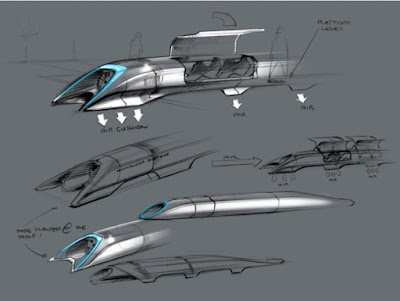Elon Musk has started building a revolutionary new transport system dubbed Hyperloop. It will allow you to travel from Bangalore to Chennai in mere 30 minutes. Musk has likened it to a vaccum tube system in hospitals used to move medications from place to place.
Confused? No worries. Here's everything you need to know about the futuristic train coming straight out of a science fiction.
First of all, What exactly is a Hyperloop?
Hyperloop is essentially a train system that Musk calls "a cross between a Concorde, a railgun, and an air hockey table". It's based on the very high-speed transit (VHST) system proposed in 1972, which combines a magnetic levitation train and a low pressure transit tube. It evolves some of the original ideas of VHST, but it still uses tunnels and pods or capsules to move from place to place.
So, How fast can it go?
Hyperloop is being proposed as an alternative to short distance air travel, where the system will be much faster than existing rail networks and much cleaner that flight. Hyperloop isn't about going as fast as possible, because you'll have to deal with high G forces when it came to turns, which isn't ideal for passenger travel. Speeds of over 700mph are suggested for journeys.
But there are practical implications that have to be considered on a short stop-start journey, such as the acceleration and deceleration sensation that passengers would go through.
How does Hyperloop achieve such speeds?
Air bearings or maglev
One of the biggest problems with anything moving is friction, both against surfaces and the environment the pod is moving through. Hyperloop proposes to move away from traditional wheels by using air bearings for pods instead. This will have the pod floating on air. It's similar to maglev, in which the electromagnetic levitation of the train means there is no friction like a traditional train that runs on tracks.
This is how current maglev trains can achieve super speeds, like the 500km/h maglev train in Japan. One Hyperloop proposal, from Virgin Hyperloop One, uses passive magnetic levitation, meaning the magnets are on the trains and work with aluminium track. Current active maglev needs powered tracks with copper coiling, which can be expensive.
Low pressure
Hyperloop will be built in tunnels that have had some of the air sucked out to lower the pressure. So, like high-altitude flying, there's less resistance against the pod moving through the tunnel, meaning it can be much more energy efficient, which is desirable in any transit system.
The original VHST proposed using a vacuum, but there's an inherent difficulty in creating and maintaining a vacuum in a tunnel that will have things like stations, and any break in the vacuum could potentially render the entire system useless. For Hyperloop, the idea is to lower the air pressure, a job that could be done by regularly placed air pumps.
Low pressure, however, means you still have some air in the tunnels.
The air bearing and passive maglev ideas are designed not only to levitate the pod, but also see the pod moving through the air, rather than pushing the air infront of it and dragging it along behind. The air cushion will see the air pumped from the front of the pod to the rear via these suspension cushions. The tunnels envisioned are metal tubes, elevated as an overground system.
What will it feel and sound like?
Virgin Hyperloop One said it will feel like you're riding in an elevator or a passenger plane. There will be tolerable G forces, as you will be accelerating and decelerating gradually, but there will be no turbulence. In terms of sound, people on the outside will only hear a "big whoosh". The tubes are constructed out of thick, strong steel and can handle 100 Pa of pressure or more.











No comments:
Post a Comment